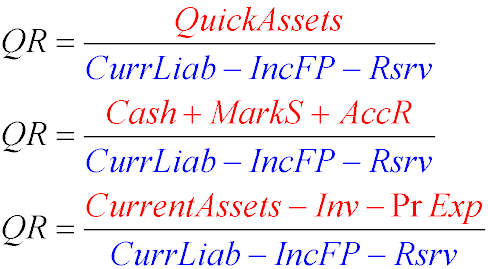|
Another important note that I would like to draw your attention to: there are often contradictions on the Internet regarding the formulas
for calculating liquidity ratios. Therefore, try to understand the essence of the ratio better. This will help you understand why these
formulas (given in this article) are more accurate.
Liquidity ratios are indicators used to assess the ability of an enterprise to pay off its liabilities using the assets at its disposal.
Since assets have different degrees of liquidity—that is, the ability to turn into cash—liabilities also have different terms for
the fulfillment of obligations by the enterprise. (Our liabilities, except for equity, are someone else's assets). Thus, the task
of liquidity ratios is to numerically evaluate the ratio of assets and liabilities with similar terms for the fulfillment of obligations/realization.
Liquidity Ratio Formulas
Current Liquidity Ratio
Current liquidity ratio (Current ratio, CR) is a financial ratio equal to the ratio of current (working) assets to short-term liabilities
(current liabilities).
This ratio shows the ability of the enterprise to pay off its debts during the period of one production cycle (the period of time required
to manufacture and sell one batch of products). It is calculated using the formula:

Let's consider how to evaluate the value of this ratio. If its value is greater than one, then there are more current assets than current
liabilities. Thus, the enterprise, theoretically, is able to fulfill its current obligations in a timely manner and carry out operational
activities. Please note that the current liquidity ratio itself does not guarantee that the company will not have cash gaps, cash
shortages, etc., since current assets include, in addition to cash, goods, materials, finished products, accounts receivable, etc.
Quick Liquidity Ratio
Quick liquidity ratio (Quick ratio, Acid test, QR) is a financial ratio equal to the ratio of highly liquid current assets to short-term
liabilities (current liabilities).
This ratio shows the ability of the company to pay off its debts during the duration of one production cycle (the period of time required
to manufacture and sell one batch of products) in the event of difficulties with the sale of goods or finished products.
It is calculated using the formula:

QR - Quick Liquidity
AccR -Short-term Accounts Receivable
MarkS - Short-term Financial Investments
Cash - All kind Cash
CurrLiab - Short-term Liabilities
IncFP −Income of Future Periods
Rsrv −Reserves for Upcoming Expenses
Let's consider how to evaluate this ratio. In the numerator, we take into account only assets whose ability to be converted into cash
does not cause us any doubts. That is, money itself, debts owed to us, and financial investments, which can also be converted into
cash in a short period of time. We correlate the resulting amount with the current liabilities of the enterprise—that is, current liabilities,
excluding amounts that are not specific obligations to pay cash. Thus, we get a value of how much the enterprise can pay for each
unit of monetary obligations if suddenly all creditors simultaneously present demands for payment.
Absolute Liquidity Ratio
Absolute liquidity ratio is a financial ratio equal to the ratio of cash and short-term financial investments to short-term liabilities
(current liabilities).
This ratio shows the company's ability to pay off current debt exclusively with available cash or its equivalents at a certain point in
time. It is calculated using the formula:

CurrLiab - Short-term Liabilities
IncFP −Income of Future Periods
Rsrv −Reserves for Upcoming Expenses
Cash - All kind Cash
ShortS - Short-term Financial Investments
Liquidity |
Описание курса
|

